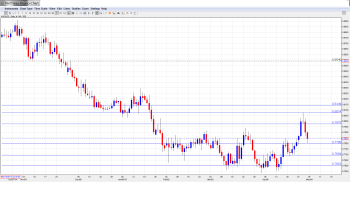The Australian dollar showed some strength during the week but was unable to consolidate and ended the week unchanged. AUD/USD closed the week at 0.7841. The upcoming week is a busy one, with 14 events. Here is an outlook on the major market-movers and an updated technical analysis for AUD/USD.
US numbers disappointed last week, as Consumer Confidence and Manufacturing PMI reports fell short of expectations. In Australia PPI was unexpectedly strong.
[do action=”autoupdate” tag=”AUD/USDUpdate”/]AUD/USD graph with support and resistance lines on it. Click to enlarge:
- MI Inflation Gauge: Monday, 00:30. The indicator, released monthly, helps analysts track consumer inflation, as CPI reports are only released each quarter. In March, the indicator rose to 0.4%, its strongest gain since December 2013.
- Building Approvals: Monday, 1:30. This major release tends to show strong fluctuations. The indicator reversed directions in February, posting a decline of 3.2%. This was slightly better than the estimate of 3.8% decline. The markets are expecting another decline, with the estimate for the March release standing at -1.7%.
- ANZ Job Advertisements: Monday, 1:30. This indicator provides a snapshot of the strength of the labor market. In March, the indicator surprised with a decline of 1.4%, its first decline since May 2014. Will we see a bounce back into positive territory in the April release?
- Chinese HSBC Final Manufacturing PMI: Monday, 1:45. The Aussie is sensitive to key Chinese data such as PMIs, as the Asian giant is Australia’s number one trading partner. The indicator continues to trade close to the 50-point level, which separates between contraction and expansion. The PMI dipped to 49.6 points in March, very close to expectations. More of the same is expected in the April report.
- AIG Services Index: Monday, 23:30. The index has shown some improvement, and has remained above the 50-point level for two straight months. The March report showed a level of 50.2 points, down from 51.7 points a month earlier.
- Trade Balance: Tuesday, 1:30. Trade Balance is closely linked to currency demand, as foreigners must purchase Australian dollars in order to purchase Australian goods and services. The deficit increased to $A1.26 billion in February, within expectations. The estimate for the March report is a deficit of $A0.98 billion.
- Cash Rate: Tuesday, 4:30. The markets are expecting the RBA to reduce rates to 2.0%, but the Bank has already defied expectations twice in 2015. Will the markets get it right this time around? Whether the RBA makes a move or not, we could see some volatility from AUD/USD. The RBA will communicate the new rate with a rate announcement.
- HIA New Home Sales: Wednesday, 1:00. The indicator slipped to 1.1% in March, compared to a gain of 1.8% a month earlier. Six of the past seven readings have been gains, pointing to growth in the housing sector.
- Retail Sales: Wednesday, 1:30. Retail Sales is the primary gauge of consumer spending, and an unexpected reading can have a strong impact on the movement of AUD/USD. The indicator posted a strong gain of 0.7% in February, marking a 13-month high. This beat the forecast of 0.4%. The estimate for the March report stands at 0.4%.
- AIG Construction Index: Wednesday, 23:30. The index punched across the 50-point line in February, posting a reading of 50.1 points. This follows four consecutive readings below the 50-point level, which separates between contraction and separation.
- Employment Change: Thursday, 1:30. This is one of the most important economic indicators, and should be treated as a market-mover. The indicator was unexpectedly strong in March, posting an excellent gain of 37.7 thousand. This crushed the estimate of 14.9 thousand. The markets are expecting a much smaller gain in the April report, with an estimate of 4.0 thousand. The unemployment rate is expected to rise to 6.2%, up slightly from the current 6.1%.
- RBA Monetary Policy Statement: Friday, 1:30. This statement is released on a quarterly basis, and will be closely monitored by analysts, as it will be issued a few days after the RBA’s rate announcement.
- Chinese Trade Balance: Friday, Tentative. Chinese Trade Balance plunged to $3.1 billion in March, down from $60.6 billion a month earlier. The estimate stood at $43.4 billion. The indicator is expected to recover in the April report, with a forecast of $34.5 billion.
- Chinese CPI: Saturday, 1:30. Chinese CPI has generally been steady, and has posted two straight consecutive readings of 1.4%. The index is expected to improve to 1.6% in the April release.
* All times are GMT.
AUD/USD Technical Analysis
AUD/USD started the week at 0.7829 and quickly dropped to a low of 0.7791, testing support at 0.7799 (discussed last week). The pair then climbed to a high of 0.8076, but was unable to consolidate at these levels and closed the week at 0.7841.
Live chart of AUD/USD: [do action=”tradingviews” pair=”AUDUSD” interval=”60″/]
Technical lines from top to bottom:
We begin with resistance at 0.8150. This line has remained intact since late January.
0.8077 was an important resistance line in January.
0.7978 was an important cap back in January 2007.
0.7799 is a weak support line. This line was tested by pair and could see further action early in the week.
0.7692 is a strong support level.
0.7601 has remained firm since mid-April.
0.7528 is the next support level.
0.7403 has held firm since May 2009. At that time, the Aussie was in the midst of a rally which saw it climb above the 0.94 line.
The final support line for now is 0.7283.
I am bearish on AUD/USD.
The RBA is expected to lower rates this week to a record low of 2.0%, and this could push the Aussie to lower ground. As well, Australian retail sales and employment numbers are expected to soften this week, which would likely push the pair downwards.
In our latest podcast we ask: Did the market get it right on the Fed’s hike? And cover the big upcoming events.
Subscribe to Market Movers on iTunes
Further reading:
- For a broad view of all the week’s major events worldwide, read the USD outlook.
- For EUR/USD, check out the Euro to Dollar forecast.
- For GBP/USD (cable), look into the British Pound forecast.
- For the Japanese yen, read the USD/JPY forecast.
- For USD/CAD (loonie), check out the Canadian dollar forecast.
- For the kiwi, see the NZDUSD forecast.

